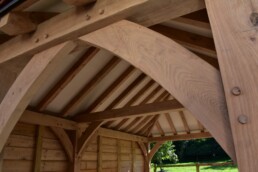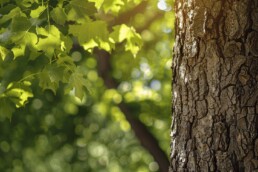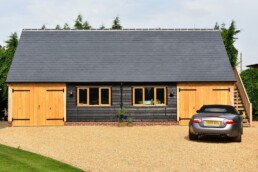Green Oak in Construction: A Sustainable Marvel
Green oak, also known as unseasoned or freshly cut oak, has been a staple material in construction for centuries. Its versatility, strength, and sustainability make it a preferred choice for architects, builders, and homeowners alike. This summary delves into the various aspects of green oak, its benefits in construction, and its contributions to sustainability.
Understanding Green Oak
Green oak refers to oak timber that has been freshly harvested and has not undergone the drying or seasoning process. Unlike kiln-dried oak, which is commonly used in furniture making, green oak retains its natural moisture content. This characteristic makes it more flexible and easier to work with in construction applications.


Structural Integrity
Despite its initial moisture content, green oak is renowned for its exceptional strength and durability. Its natural properties make it well-suited for load-bearing structures such as timber frames, beams, and trusses. The inherent density of oak allows it to withstand heavy loads and resist decay, ensuring the longevity of the structure.
In traditional timber framing, green oak is often used for its ability to support substantial weight without the need for additional reinforcement. This makes it an attractive option for buildings where large spans and open floor plans are desired. Additionally, green oak’s flexibility allows for intricate joinery techniques, enabling builders to create complex and visually stunning architectural elements.
Sustainability
One of the most compelling aspects of green oak is its sustainability. Unlike many modern construction materials that rely on energy-intensive manufacturing processes, green oak is a renewable resource that requires minimal processing. By utilising sustainably sourced oak timber, construction projects can significantly reduce their carbon footprint and promote sustainable practices.
Green oak also has a lower embodied energy compared to other building materials such as steel or concrete. Embodied energy refers to the total energy consumed during the extraction, processing, transportation, and installation of a material. Since green oak requires minimal processing and can often be sourced locally, its embodied energy is relatively low, making it an environmentally friendly choice for construction projects.
Furthermore, green oak is biodegradable and can be easily recycled at the end of its lifespan. Unlike synthetic materials that may end up in landfills, oak timber can decompose naturally, returning nutrients to the soil and minimising environmental impact. Its longevity and ability to be repurposed make it a sustainable option for construction projects seeking to minimise waste and resource consumption.


Environmental Benefits
In addition to its sustainability, green oak offers various environmental benefits. Oak trees, the source of green oak timber, are known for their carbon sequestration capabilities. Through the process of photosynthesis, trees absorb carbon dioxide from the atmosphere and store carbon in their biomass. By using oak timber in construction, carbon remains stored within the wood, effectively reducing carbon dioxide levels in the atmosphere.
Furthermore, oak forests provide habitats for diverse ecosystems and contribute to biodiversity conservation. Sustainable forestry practices ensure the regeneration of oak forests, preserving their ecological value and supporting local wildlife populations. By choosing green oak as a construction material, builders can contribute to the preservation of natural habitats and the protection of biodiversity.
We couldn't be happier with the work that James and his team have done for us. In fact, it has exceeded our expectations. Anyone who has seen our new rooms have been bowled over by them and we would recommend The Cartlodge Company wholeheartedly to anyone - in fact we have done!
John & Tracey, Ware
Thermal Performance
Green oak also exhibits excellent thermal properties, making it an ideal choice for energy-efficient construction. Its natural insulating properties help regulate indoor temperatures, reducing the need for artificial heating and cooling systems. Oak timber has a relatively low thermal conductivity, meaning it does not readily transfer heat or cold. This results in more stable indoor temperatures and improved comfort for building occupants.
In addition to its insulating properties, green oak’s thermal mass can help stabilize temperature fluctuations within a building. Thermal mass refers to a material’s ability to absorb, store, and release heat over time. By incorporating green oak into building designs, construction projects can achieve higher levels of energy efficiency and reduce operational costs over time.


Aesthetic Appeal
Beyond its structural and environmental benefits, green oak boasts a timeless aesthetic appeal. Its rich colour, distinctive grain patterns, and natural imperfections add character and charm to any architectural design. Whether used in traditional timber framing or contemporary structures, green oak lends a sense of authenticity and warmth to the built environment.
In timber framing, green oak is often left exposed to showcase its natural beauty. Over time, oak timber develops a beautiful grey patina as it weathers, further enhancing its visual appeal. Treating green oak is personal preference, however, it is naturally weather resistant and greys with age and exposure. Additionally, green oak can be easily shaped and carved to create intricate details and decorative elements, allowing architects and builders to incorporate unique design features into their projects
Oak framed buildings will develop cracks (known as shakes) it is a completely normal and natural process. The splits which open up along the grain as the fibres dry and separate do not traverse the beams grain and thus do not weaken it. Predicting shrinkage is part of our calculations and the oak frame is designed so that this process will make your frame stronger, as it shrinks around the dry oak pegs which are fixed through the joints.
Fire Resistance
Due to its density, oak is remarkably resistant to fire even when dried, making it a safe and reliable choice for construction. Should fire occur, once the outer layer has charred the charcoal itself acts as an insulant slowing the transfer of heat to the core and on the surface forms a protective layer that insulates the inner fibres of the wood, unlike some other building materials that may combust or melt when exposed to high temperatures. Oak framed buildings like all others must comply with the fire safety requirements set by the building regulations department.
Conclusion
In conclusion, green oak stands as a sustainable marvel in construction, offering unparalleled structural integrity, environmental benefits, and aesthetic appeal. Its renewable nature, minimal environmental impact, and superior performance make it a preferred choice for architects, builders, and homeowners seeking to create beautiful and sustainable buildings. By embracing green oak in construction projects, we not only build structures that stand the test of time but also contribute to a more sustainable and resilient built environment for future generations.

